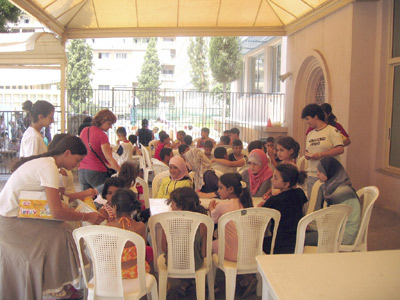While some describe Lebanon in easy “Muslim” and “Christian” terms, the reality is much more complicated. The government recognizes 17 religious groups in the country. While their different beliefs are easy to describe, the relative size of the various groups is more difficult to pin down. Because of the delicate political balance in the country, a census has not been conducted since 1932. The estimates on the 13 sects described below are largely based on information collected during the 1980s.
 Lebanese Baptist volunteers serve children of refugee families at the Beirut Baptist School. Fighting has brought thousands of Muslim refugees into the city – and into contact with Christians they might never otherwise meet.
Lebanese Baptist volunteers serve children of refugee families at the Beirut Baptist School. Fighting has brought thousands of Muslim refugees into the city – and into contact with Christians they might never otherwise meet.Muslim sects- 59.7 percent
Sunnis – Orthodox Sunni Muslims stand for the original simplicity of Islam and against later innovations. They regard the Koran, supplemented by the traditions of the Muhammad, as the sole and sufficient embodiment of the Muslim faith. Under the French Mandate in Lebanon, Sunnis were vested with much political power. In 1986, an estimated 595,000 Lebanese (27 percent of the population) were Sunnis, the majority living in urban centers.
Shias – Shiite Muslims in Lebanon are divided into two factions. Shias generally have occupied the lowest stratum of Lebanese society and have been concentrated chiefly in the poor districts of Beirut and southern Lebanon. They have been organized and influenced by Iranian clerics. As of 1987, Shias numbered an estimated 919,000 (41 percent). Hezbollah (“Party of God”) has been the most important religious influence among Lebanon’s Shias since the early 1980s.
Alawis – Alawis are descendants of a people who lived in the mountains of northern Lebanon and western Syria for thousands of years. They integrated elements of both Christianity and Islam. For example, Alawis celebrate Christmas and Easter and use sacramental wine in some ceremonies. Regarded as infidels in the past, they were persecuted and heavily taxed. Alawis numbered only a few thousand in 1987.
Druze – The Druze are an offshoot of a version of Islam brought to Lebanon from Egypt by a teacher named Darazi. Though they are a minority in the country, their significant political influence was based, in part, on support from the British. The Druze constituted about 7 percent of the population (153,000) in 1987. More than half resided in rural areas.
Christian sects- 39 percent
Maronites – Maronites are an indigenous Lebanese church related to the Roman Catholic Church. In the late seventh century, Maronites were persecuted by other Christians for their beliefs; they migrated from the coastal regions into the mountainous areas of Lebanon and Syria, where they came into conflict with the Druze. Maronites traditionally have occupied the highest stratum of Lebanese society and, with the patronage of France, have been closely associated with the political system of independent Lebanon. In 1986, there were an estimated 356,000 Maronites in Lebanon (16 percent).
Greek Catholics – Greek Catholics emerged as a distinct group in the early 18th century when they split from the Greek Orthodox Church. They accept Catholic doctrines as defined by the Vatican but have remained close to the Greek Orthodox Church, retaining many of the ancient rituals and customs. Greek Catholics live primarily in the villages of central and eastern Lebanon. Greek Catholics constituted 3 percent of the population (72,000) in 1986.
Roman Catholics – Known as “Latins,” Roman Catholics comprised less than 1 percent of Lebanon’s population in the 1980s. The Latin community is composed primarily of foreigners, mainly Europeans.
Greek Orthodox – The Greek Orthodox adhere to the Orthodox Eastern Church, which, in the fifth century, diverged from the Roman Catholic Church over the nature of Christ. The Greek Orthodox have become increasingly urbanized and form a major part of the commercial and professional class. Known for their pan-Arab orientation, the Greek Orthodox often have served as a bridge between Lebanese Christians and the Arab countries. Members of the sect constitute 5 percent of the population.
Jacobites – The Jacobites, often referred to as the Syrian Orthodox Church, take their name from Jacob Baradeus, who, in the sixth century, spread throughout Syria the teaching of the church that Christ had only one nature – divine. As of 1987, there were only a few thousand Jacobites in Lebanon.
Armenian Orthodox – The Armenian Orthodox, or Gregorian, Church was organized in the third century around a belief in the single divine nature of Christ that is slightly different from the belief of the Syrian Orthodox Church. The Armenians in Lebanon were refugees who fled Turkey during and after World War I.
Nestorian Church – The Nestorian, or Assyrian, Church is the remnant of the fifth-century movement that saw Christ as consisting of two separate persons, one human and one divine, as opposed to having two natures in one person. Its doctrine was condemned by the Council of Ephesus in 431 A.D. Subsequently, those Nestorians who accepted this doctrine formed an independent church.
Protestants – The Protestants in Lebanon emerged in the 19th and 20th centuries from the work of missionaries, primarily English and American. They are divided into a number of denominations, the most important being Presbyterian, Congregational and Anglican. They constitute less than 1 percent of the population and live primarily in Beirut.
Evangelicals – Evangelicals in Lebanon have emerged in the 20th century from the work of missionaries, primarily American, who represented groups such as Baptists and the Assemblies of God. They constitute less than 1 percent of the population.